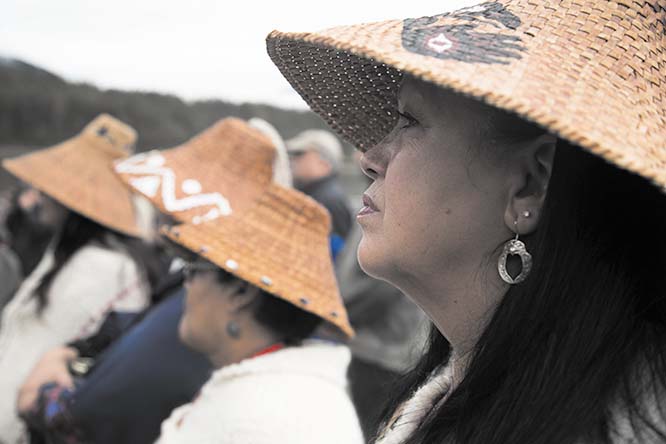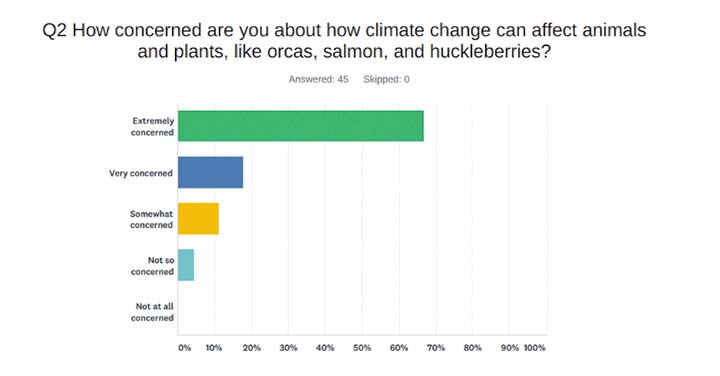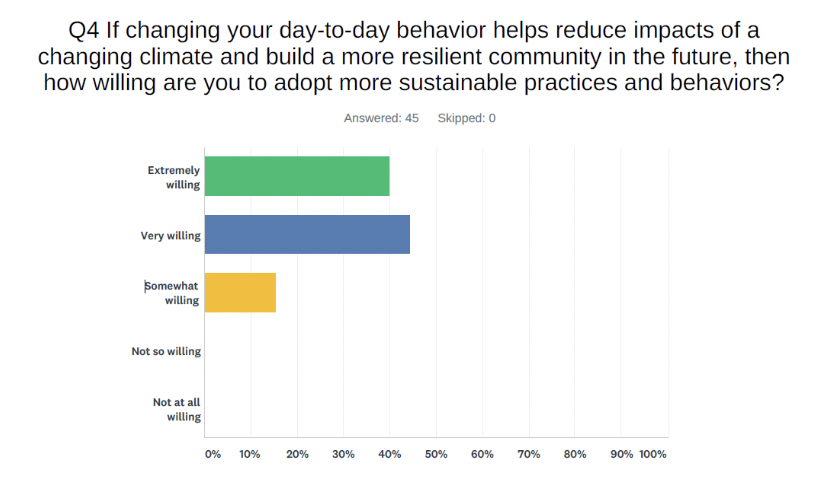
By Ben Lubbers, Associate Planner, Tulalip Tribes
When you talk to Patti Gobin in the Tulalip Tribes Natural Resources Department about how a changing climate will impact her people’s treaty rights and how they plan to adapt; it doesn’t take long to realize that the Tulalip Tribes are strong and ready for change.
After a listening session with Gobin; Tulalip’s Climate Adaptation Core Planning Team learned that for the Tulalip people, adapting to change isn’t something new. “Since time immemorial Coast Salish people have been dealing with changes that have impacted how we live our lifeways” said Gobin. “Both the coming of western civilization and an economy based society and changing climate have had impacts”. So, for Gobin and the Tulalip people, “Being strong and resilient to change is already a part of who we are and how we live.”
According to Gobin, their approach comes from a place of strength. It’s connected to the cultural values that have been passed down through traditional stories, teachings, and songs. “We must be prepared to address the changes coming our way to live the resiliency our ancestors handed down.” said Gobin. For the Tulalip people, the value of following and upholding the teachings of their ancestors is taught by the traditional story – Her First Basket.
Stories and values like these guide the work of Tulalip Tribes Government and Tulalip’s Climate Adaptation Core Planning Team. For Verna Hill, Director of Tulalip’s Community Health Department, these values are ingrained in her day to day work. She and her team know the value of strengthening people, which is one of the core values taught by the traditional story of – Mud Swallow’s House.
Through their policies and programs the Community Health Department is building a strong and resilient community one person at a time. Are they concerned about vulnerable populations affected by longer fire seasons and poor air quality? Absolutely, but together with the Climate Adaptation Core Planning Team, Hill has been identifying community health concerns that may get worse as a result of climate change. That way they can plan ahead and make adjustments to meet the changing needs
In addition to community health concerns, many people consider climate change an emergency! According to a recent climate change survey, residents in Tulalip are concerned about the negative impacts that environmental hazards might have. That is where Tulalip Tribes Emergency Manager, Ashlynn Danielson steps into help. Through the Tulalip Tribes Hazard Mitigation Plan these concerns are being looked at, addressed, and prioritized.
In some cases more frequent wind storms may cause more frequent power outages. Together with the Public Works Department and Tulalip Utilities Department, Danielson has worked to increase the amount of back-up generators for Tribal facilities like the Tulalip Health Clinic and new police and court buildings. In addition, Tulalip Public Works has developed a new fuel reserve located on the Reservation to serve as a back-up in case fuel in needed to keep generators going longer. For Danielson and her team they embrace the opportunity to uphold and serve their people, a value that is highlighted by the traditional story – How Daylight was Stolen.
Similarly, Danielson, and the Climate Adaptation Core Planning know the importance of listening to people. According to Danielson, you don’t need to be a climate scientists to help your community plan and adapt. Everyone has something to offer in terms of observing and providing information to better understand the changes we are experiencing. Showing respect and listening to every individual is a cultural value that is identified in the traditional story- Lifting Up The Sky. Listening to elders, youth, tribal leaders, fisherman, employees, tribal members, and community members is an important part of Tulalip’s efforts to adapt and plan for change.
In November of 2019, the Climate Adaptation Core Planning Team worked with the Tulalip Communications Department and sent out a survey to find out what the community thought about Climate Change and Hazard Mitigation topics. According to the survey results 44% of survey respondents have noticed more frequent extreme weather events in our community and 88% of respondents have noticed changes in temperature. In addition, survey respondents said they noticed changes to the environment including 28% noticing more frequent flooding and 26% noticing landslides/mudslides.
Unfortunately, for many Indian Tribes across the country climate change has had a much larger impact on their way of life. Reservations are typically more isolated and indigenous people generally live closer and are more dependent on the environment. Therefore changes to the climate and the environment can impact tribes more directly than other people or communities.
For the Tulalip people and other Coast Salish tribes this includes impacts to the rivers, forests, and oceans they depend on. When these areas are negatively impacted access to treaty rights such as fish and shellfish are impacted. According to the Tulalip Tribes Climate Change and Hazard Mitigation Survey 66% of survey respondents were concerned about how climate change will impact plants and animals like orcas, salmon, and huckleberries.

Because of this disproportional impact, the Tulalip Tribes and other Native American Tribes have taken the lead when it comes to planning for climate change. According to a database maintained by the University of Oregon, at least 50 tribes across the U.S. have assessed climate risks and developed plans to tackle them. With more than 570 federally recognized tribes controlling 50 million combined acres, Tribal planning and adaptation efforts are building resilient communities throughout Indian Country.
For the Tulalip Tribes and other Native Nations in the Pacific Northwest the need for healthy rivers, forests, and oceans that can support healthy salmon runs is at the forefront of these planning efforts and has been for decades. This work includes a larger effort to coordinate with, and in some cases litigate, city, state, county, and federal agencies in order to advocate for and protect tribal treaty rights. A lot of this coordination has to do with sharing scientific information, reviewing data, and talking to Tribes to better understand what the impacts are.
To better understand the extent of climate change impacts, the Tulalip Climate Adaptation Core Planning Team is closely monitoring the latest regional and global scientific information. In addition, they are studying and monitoring local conditions right here in Tulalip. This includes conducting scientific studies as well as gathering information about the local area from tribal members, tribal elders, and other community members.
In some cases this information includes memories and connections to special places that have been passed down from grandparents to parents. This information is important to help prioritize and protect these special places both on and off the Reservation. Respecting the community of our elders past and present, and paying attention to their good words is a cultural value that is represented in the story of the – Crane and Changer.
One of the special places that is being impacted by climate change is the shoreline. According to Tulalip’s Climate Change and Hazard Mitigation Survey 28% of respondents have witnessed coastal erosion over the years and 42% have noticed damage to our roads and other infrastructure. Tulalip’s Natural Resources Department is working hard to determine the extent of the problem. In some cases coastal erosion is natural, but according to observations from Tulalip fisherman coastal erosion seems to be happening more often that in the past.
To help address this issue the Tulalip’s Climate Adaptation Core Planning Team has been monitoring the science and potential impacts that sea level rise could pose in our area. One way to do this is to go out in the field and monitor vulnerable low lying coastal areas during annual king tides. The king tides provide a glimpse 25-50 years into the future to a time when our regular high tides could potentially reach these levels. Monitoring the largest tides of the year helps Tulalip figure out the places and infrastructure that are most vulnerable.
However, instead of just monitoring and planning for these changes, the Tulalip government and its community also want to reduce the impacts of climate change by reducing carbon emissions. According to the Intergovernmental Panel on Climate Change (IPCC) cutting carbon emissions from energy and transportation sources will not be enough. The IPCC states that in order to keep global temperatures at safe levels we also need to transform the way the world produces, packages, and transports food. This will require a sincere effort by individuals, governments, non-profits, local business, and corporations from around the world to change. Specifically, we need to change how we provide and consume our energy and food. This means changing the way get around, changing the way we heat our homes/work, and changing where and how we get our food.

Taking doctor’s orders from Mother Earth, isn’t something that everyone is willing to do. However, according to Tulalip’s Climate Change and Hazard Mitigation survey 84% of respondents are either extremely willing or very willing to change their day to day behavior to help reduce the impacts of climate change. This could be as simple reducing the amount of beef in your diet or tele-commuting to work. However, this could also mean encouraging government, tribal leadership, and businesses to take action. Both governments and business around the world have an opportunity to make changes that will help us lessen the impacts of climate change while at the same time protecting vulnerable populations of people while also stimulating the economy.
Addressing and prioritizing all the issues associated with climate change takes a lot of work. Work that requires us to educate and communicate with each other. Work that requires us to monitor, observe, plan, and prioritize mitigation and adaption efforts. At times the amount of work that needs to be done can feel overwhelming. However, its times like these that we can turn to the Tulalip Tribes traditional and cultural values for guidance and support. This includes the cultural value of working hard and always trying our best. This value is represented in the traditional story- How we got the Salmon Ceremony. It’s through the understanding of these values that we know the Tulalip Tribes are strong and ready for change.
For more information about Tulalip Tribes Climate Adaption and Hazard Mitigation efforts please visit the following websites.
Tulalip Office of Emergency Management
https://www.tulaliptribes-nsn.gov/Dept/OfficeOfEmergencyManagement
Tulalip Natural Resources – Climate Change Page